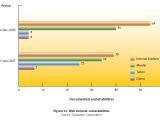Internet Explorer, Firefox, Safari and Opera are four products in a constant race for the dominant position on the browser market. For the time being, Microsoft's Internet Explorer has the lead and there's a huge gap that separates it from its nearest rival, Firefox. Safari and Opera are trailing IE and Firefox from the distance, and without making any real progress. The latest statistics, as of August 2007, reveal that IE accounted for a share of 78.7% of the browser market, Firefox for 14.5%, Safari for 4.7% and Opera for 0.9%. Still, in terms of security, the top four browsers are ranked in a different order. As a matter of fact, turning the market share top four up-side down results in the security ranking, according to the Symantec Internet Security Threat Report Trends for January-June 07.
Opera is the browser affected by the fewest vulnerabilities in the first six months of 2007. "In the first six months of 2007, Symantec documented seven vulnerabilities that affected Opera. Of these, three were medium severity and the other four were low. The total of seven is an increase from the four vulnerabilities that affected Opera in the second half of 2006, two of which were considered medium severity and two of which were low," Symantec revealed.
Just take a look at the graphic included towards the bottom of this article in order to make an idea of the volume of security flaws impacting the four browsers in the first half of this year. You will be able to see that Internet Explorer is the clear leader when it comes down to the collection of vulnerabilities it has managed to gather between January and June 2007. What is interesting is that this period is synonymous with the availability of Windows Vista and of Internet Explorer 7, both products advertised as apexes of security.
"During the first six months of 2007, Symantec documented 39 vulnerabilities in Microsoft Internet Explorer. Of these, one was considered to be high severity, 15 were medium severity, and 23 were low. This total is a decrease from the 54 vulnerabilities documented in the second half of 2006. Of those, one was considered high severity, 13 were medium severity, and 40 were low," reads a fragment of the Symantec report.
Still, as the graphic indicates, both Internet Explorer and Firefox had a consistent number of vulnerabilities, less than in the last half of 2006. Not the same can be said about Safari and Opera. While IE dropped from 54 holes to 39, and Firefox from 40 to 34, Safari's vulnerabilities exploded from just four in July-December 2006 to no less than 25.
"Safari was affected by 25 vulnerabilities in the first half of 2007. Seven of these were medium-severity vulnerabilities, and the other 18 were low severity. This is an increase from the four Safari vulnerabilities that were documented in the second half of 2006. Of these, two were medium severity and two were low severity," the Symantec report adds.
The Cupertino-based security company explained the escalation in Safari vulnerabilities in relation to Apple transitioning its browser for the 32-bit and 64-bit Windows Platform. Symantec emphasized however that the vast majority of security holes received a severity rating of low, successful exploitation leading to just denial of service, information disclosure, and spoofing. But when it comes down to the ultimate browser face-off between Internet Explorer and Firefox, Mozilla's open source browser is by far the most secure of the two.
"During the first half of 2007, 34 vulnerabilities were disclosed that affected Mozilla browsers. Of these, 12 were considered to be medium severity and 22 were considered low. This total is a decrease from the 40 vulnerabilities that affected Mozilla browsers in the second half of 2006. Of those, 35 were considered medium severity and five were low severity", Symantec explained.

 14 DAY TRIAL //
14 DAY TRIAL // 
